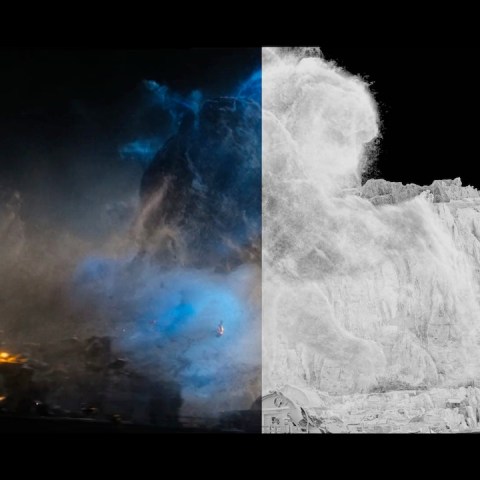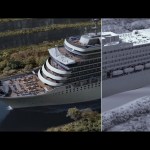Behind Scanline VFX’s Gotham City flooding scenes in ‘The Batman’.
The third act of Matt Reeves’ The Batman sees the Riddler orchestrate a series of bombs to destroy the breakwaters around Gotham City, causing major flooding. When people seek refuge inside Gotham Square Garden, a tsunami of water also threatens to wreak havoc.
Scanline VFX, working with production visual effects supervisor Dan Lemmon, was responsible for the Gotham flooding moments and scenes inside the arena. The team had to simulate water, extend partial sets and deliver a digi-double and take-overs of Robert Pattinson’s Batman, where necessary.
Here, befores & afters asked Scanline visual effects supervisor Julius Lechner about the detailed work involved.
b&a: Starting with the build, say for exterior shots for Gotham, what did that involve for Scanline?
Julius Lechner: The location of the plates shot for Gotham Square Gardens was in Chicago, but that actual building is a shopping centre I think, so we had to make it feel like an arena. We had some references from real stadiums, and probably the one that we referenced the most was Madison Square Garden in New York.
b&a: And were you building that up from reference and any kind of scanning or photogrammetry or LIDAR of any real places that helped inform that?
Julius Lechner: We did have a scan of the exterior location in Chicago, but the reference for inside was a completely different place. The inside of the arena is based on The O2 arena in London. We also had scans for that and a lot of texture photography. In the environment we built, the ground level and up to a certain height is based on O2 arena with the entrance changed, and then everything above a certain height is mostly made up. We still based it on O2 arena but because of the story and the action that happens in the third act, we had to construct it very differently to allow for all these things to happen.
Matt really wanted to make sure that it felt big, that we have a lot of depth. Everywhere you look, you always see tonnes of details in the background. So we ended up adding more and more and more into this arena. It was a pretty heavy build in the end.

b&a: For that rafters fight with all the, I’m going to describe them as assassins, but they probably have a proper name, the Riddler’s group that turns up and there’s a lot of stunts, were they effectively shooting that on partial scaffolding sets against bluescreen?
Julius Lechner: Exactly. We had partial sets and extended the background. They used the same set but actually the story is shooting in different directions. We had to put the plates together and reconstruct that entire set, which was basically a big square around the Jumbotron there. Again, Matt had a pretty clear idea of what he wanted the environment to look like.
We also did some face replacements for the stunt fighting using Eyeline Studios’ volumetric capture tools. Here we’d be replacing Robert’s face onto a stunt actor’s performance. It was great because we could, instead of using a digi-double to do the face replacement, really capture Robert’s performance.
b&a: Let’s talk about the moment that parts of the city are blown up and basically a tsunami of water happens. Tell me about the approach you took to doing that kind of water work.
Julius Lechner: What was really important for Matt, Dan and for ourselves was to make it feel as real as possible, not over the top, because it’s not that kind of movie. We had a lot of reference of real tsunamis to study how everything interacts with the water. So, you have cars, but then maybe they hit a barrier. Then that creates a bit of a blockage which means the water has to go around that. It was really important that all the pieces of the simulation talk to each other.
The way we built the setup is that the artists could really creatively define where we have these blockages and where the water needs to run and how it flows. That was a big part of our setup work, but also to make sure it really looked as real as possible.
b&a: Are there any particular tools Scanline is using these days for that kind of setup?
Julius Lechner: We have different options. In this case, it was a mix of Houdini for the rigid body simulations, and Flowline for the water.

b&a: Were they able to shoot any kind of water interaction or practical stuff for you to reference for the flooding?
Julius Lechner: It was helicopter plates without any water. For the shots that are closer, in the arena, there was a lot of practical water there. We also had, for the explosion shots, actual real explosions. We did end up replacing parts of the environment and enhancing the explosion with additional CG explosions, but it was nice to have something real to work with. I think that always ends up being the best result when it’s the best of both worlds.
b&a: What about the moment that the water ‘crashes’ into the arena? That’s quite spectacular. I really felt that was almost like a practical stunt, but I’m sure it wasn’t.
Julius Lechner: No, it wasn’t.
b&a: How did you approach that moment?
Julius Lechner: It’s a big sim. We wanted to make sure that we were able to address notes and that we could iterate fast enough. So we always ran proxy sims that we used to interact with the environment and all the debris so that we could really orchestrate the effect as much as possible without relying too much just on the simulation.
b&a: For water inside the arena, what did you need to know about the way water behaves, or the way Matt wanted water to behave, on the floor of an arena?
Julius Lechner: It really needed to be as real as possible. The way we treated foam and spray was a little bit different than we had done previously, because everything got muddy. We wanted to make sure if there was, say, a dirty patch, that all that discoloration in the water actually continues into the spray and the mist so that it’s not all just one color. We could actually do that after the fact. So that even after we had the sim we could control, okay, we want some more dirty water here, some more dirty water here, a bit more clear here, without having to re-run every sim.
b&a: There’s a moment when Batman kind of sacrifices himself by falling into the water. Did Scanline need to do digi-double, or a takeover, there?
Julius Lechner: It was a bit of both. There’s a close-up shot where he cuts the cable and that’s a combination. We did have a plate, but we replaced parts of his body and then did a take-over into a digital version of him. Then we did have some plates for the shot right after where he falls down and you see him hit the water. There was a lot of practical stuff for that, but we had to sim the interaction of him as he hits the water, and that light truss falling into the water and then combine it with the real plate, which is always a challenge because you need to make the sim seamlessly blend into real photography of water.
b&a: There’s also those very iconic shots of him leading the crowd out with the flare.
Julius Lechner: That was actually one of the first plates that we saw. It was very exciting, right away when we saw it, because I said, ‘Oh my God, that looks great!’ It was a plate, but we added additional people that interact with the water and extended the water out. The flare was real, Batman was real. He was in a pool on set which we extended and added water in the background as well.

b&a: Any particular challenges from just making sure the glow and reflection and color was working everywhere?
Julius Lechner: Well, it’s such a specific color, that as soon as it’s even slightly different in the way it reacts when it hits a digi-double or if it’s not exactly that same color, you might notice it. So we had to keep a note of that.
b&a: Was there anything else in that flooding sequence that you really wanted to mention that was tough or challenging?
Julius Lechner: We were really happy with how the whole sequence fit into the rest of the movie. There’s so much stuff that was shot for real, and then there’s actually also so many things that look like they were shot for real, but are actually CG.
Then there’s the lens-matching work. We had these crazy lenses that we had to make our stuff match to. I really like these lenses because they really draw your attention to the center of the screen and also have crazy bokeh and crazy lens smearing on the outside.
b&a: How did you do that? Was that just literally eye-matching, or was there any kind of special comp set-up that helped?
Julius Lechner: We built our own set-ups for comp to match the bokeh and to match that lens characteristic. In terms of bokeh, it made such a difference how the shot felt, depending on how your deep focus background looks.


















